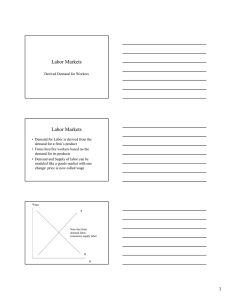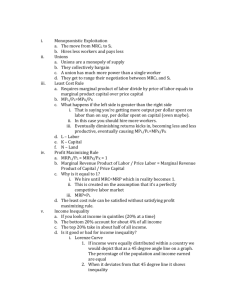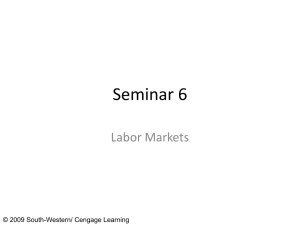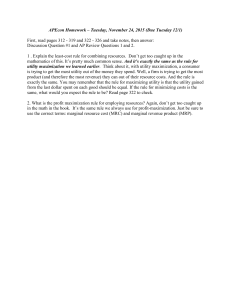Econ 601: Basic Economic Analysis Assignment #5
advertisement
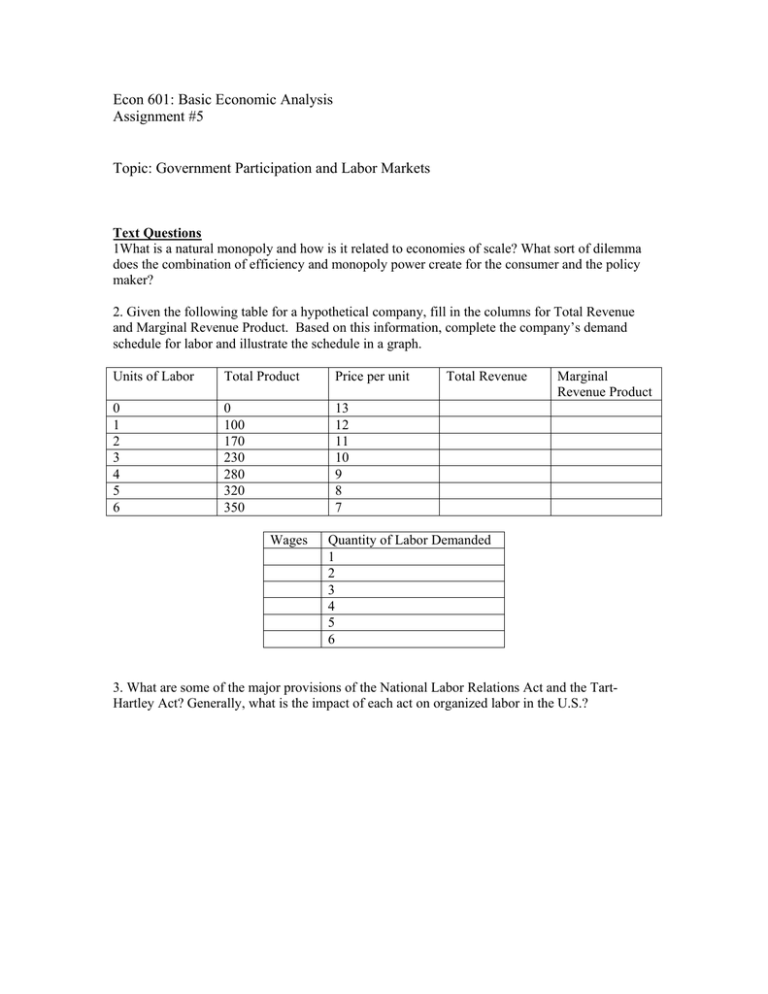
Econ 601: Basic Economic Analysis Assignment #5 Topic: Government Participation and Labor Markets Text Questions 1What is a natural monopoly and how is it related to economies of scale? What sort of dilemma does the combination of efficiency and monopoly power create for the consumer and the policy maker? 2. Given the following table for a hypothetical company, fill in the columns for Total Revenue and Marginal Revenue Product. Based on this information, complete the company’s demand schedule for labor and illustrate the schedule in a graph. Units of Labor Total Product Price per unit 0 1 2 3 4 5 6 0 100 170 230 280 320 350 13 12 11 10 9 8 7 Wages Total Revenue Marginal Revenue Product Quantity of Labor Demanded 1 2 3 4 5 6 3. What are some of the major provisions of the National Labor Relations Act and the TartHartley Act? Generally, what is the impact of each act on organized labor in the U.S.? Analytical Question #workers per day 0 1 2 3 4 5 6 7 8 Total pizzas/day MPL 0 X 45 45 75 30 95 20 102 7 105 3 106 1 106 0 101 -5 Price of Pizza $5 $5 $5 $5 $5 $5 $5 $5 $5 Total Revenue $0 225 375 475 510 525 530 530 505 MRP $0 225 150 100 35 15 5 0 -25 Daily Wage $32 $32 $32 $32 $32 $32 $32 $32 $32 Change in Profit $193 118 68 3 -17 -27 -32 -57 1. Suppose that the demand for pizza suddenly plummets to a market price of $3. Assuming that only the price of pizza changes from the table above, recalculate the MRP. Predict the change in the pizzeria’s hiring decision that will result from the change in the price of pizza. What would have happened if, instead of the price changing, the wage rate increased to $40/day. Multiple Choice Questions 1. If you have diminishing marginal utility for income, then as you work more to make greater income: a. b. c. d. your total utility for income diminishes. your marginal utility for leisure increases. your marginal utility of income varies positively with the money you earn. your wage falls. 2. Jane loves to work. She does not receive any enjoyment from leisure time. The last dollar that she earns each year means just as much to her as the first dollar. Which of the following best describes the share of Jane’s labor supply curve? a. Upward sloping. b. Backward sloping. c. Downward sloping. d. Horizontal. 3. The number of hours that a worker is willing to work is determined by the trade-off between: a. b. c. d. increasing marginal utility of income and decreasing marginal utility of leisure. increasing marginal utility of leisure and decreasing marginal utility of income. increasing total utility of leisure and decreasing total utility of income. increasing marginal utility of both income and leisure. 4. The demand for labor and other factors of production typically declines in a recession because those factors: a. b. c. d. have become relatively scarce. are no longer offered for sale in factor markets. are derived from the demand for final output, which also declines in a recession. all of the above. 5. Which of the following would affect the market demand for labor, ceteris paribus a. b. c. d. the marginal physical product. the productivity of labor. the demand for final products. all of the above. 6. If the MPP of an additional unit of labor is 2 units per hour, product price is constant at $6 per unit, and the wage rate is $15 per hour, then: a. b. c. d. the additional unit of labor should be employed. the additional unit of labor should not be employed because it costs more than it is worth. the employed should lower wages and accept less employment of labor. product price must be reduced if profits are to be made. 7. If a firm hires workers up to the point where the MRP of the last worker hired is greater than the wage rate: a. b. c. d. profits are maximized. the firm has hired too many workers. the firm should use more capital in its production process. the firm has not hired enough workers. 8. As labor productivity increases, which of the following shifts in the labor market should result? a. b. c. d. Supply of labor should shift upward. Supply of labor should shift downward. Demand for labor should shift to the left. Demand for labor should shift to the right. 9. At the equilibrium wage in a competitive market: a. b. c. d. MRP = wage rate. the ratio of the MRP to the factor’s price is the same for all factors. the market demand curve for labor intersects the market supply curve of labor. all of the above. 10. What will happen to wages and the level of unemployment in a competitive market when the government eliminates a minimum wage, ceteris paribus? a. b. c. d. Wages will rise but employment will fall. Wages will fall but employment will rise. Both wages and employment will fall. Both wages and employment will rise. 11.Suppose Silvia’s Table Company uses both labor and capital to produce tables. Given her current use of labor and capital, the cost efficiency of labor is 0.4 tables per dollar and the cost efficiency of capital is 0.6 tables per dollar. Silvia should: a. b. c. d. hire less labor and more capital. hire less capital and more labor. use all capital to produce tables. use all labor to produce tables. Use the following table to answer questions 12-15. # Workers/hr 1 2 3 4 5 Total Output/hr 4 10 15 19 22 MPP Total Rev./hr 12 The MPP of the third worker hired is: a. b. c. d. 15 units/hr. 4 units/hr. 3 units/hr. 5 units/hr. 13. The MRP of the second worker hired is: a. b. c. d. $6/hr. $20/hr. $12/hr. $11/hr. 14. The contribution to total revenue of the fourth worker is: a. b. c. d. $38/hr. $19/hr. $4/hr. $8/hr. 15. How may workers should be hired? a. 2. b. 3. c. 4. d. 5. MRP

